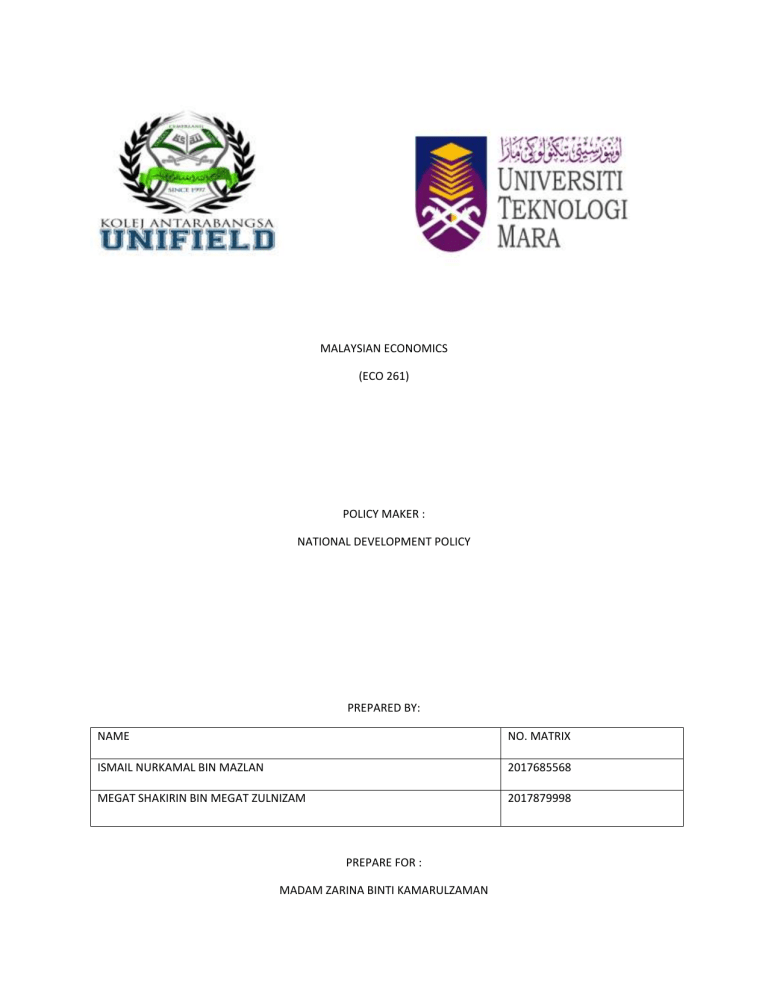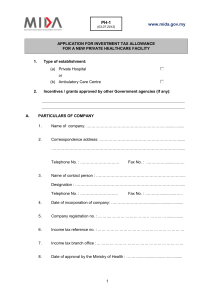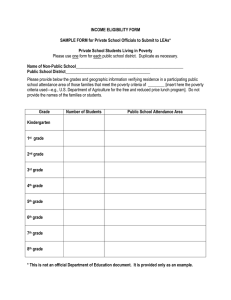
MALAYSIAN ECONOMICS (ECO 261) POLICY MAKER : NATIONAL DEVELOPMENT POLICY PREPARED BY: NAME NO. MATRIX ISMAIL NURKAMAL BIN MAZLAN 2017685568 MEGAT SHAKIRIN BIN MEGAT ZULNIZAM 2017879998 PREPARE FOR : MADAM ZARINA BINTI KAMARULZAMAN ACKNOWLEDGEMENT Alhamdulillah, first of all the highest gratitude and praise to the Al-Mighty, Allah SWT for his blessing and strength for us to complete this individual report. Surely without His help, We would be dumbfounded and stuck with many barriers that we had faced. Peach and prayers be upon Our Messenger, Prophet Muhammad SAW, family and friends. It always a pleasure to remind the fine people in the Unifield Interntional College for their sincere guidance we received to an experience which make us gained a lot of knowledge on Malaysian Economy. First of all ,thanks to our parent for giving encouragement, enthusiasm and invaluable assistance to us. Without all this, we might not be able to complete this subject properly. Second, we would like to thanks to Madam Zarina for give us the opportunity to complete this report which we received the strength a good support and motivation. Thirdly, we also want to thanks to our classmates which giving us a direct and undirect support on this assignment which no matter how hard it is. I TABLE OF CONTENT NO. TOPIC PAGES 1 ACKNOWLEDGEMENT i 2 OBJECTIVES POLICY 1 3 VISION AND MISION POLICY 2 4 ROLE POLICY 3 5 STRATEGY POLICY 4 6 TARGET FOCUS GROUP 5 7 ADVANTAGES POLICY 6-7 8 CHALLENGES OF POLICY 8 9 TARGET GOAL’S POLICY 9 OBJECTIVE OF THE POLICY National unity will continue to be the ultimate goal of the NATIONAL DEVELOPMENT POLICY because of the unified community it is important to reinforce social and political stability and sustainability continuous economic development. The NATIONAL DEVELOPMENT POLICY sets a step towards enabling Malaysia has achieved the status of a developed nation in all aspects of social justice, values, ethics and morals, political stability, quality of life, government administration efficiency, and economic excellence. 1 VISION AND MISSION OF THE POLICY The vision and mission of this policy are we will continue to maintain the NEP's basic strategy of eradicating poverty and restructuring the society to improve social and economic imbalance between people and this will contribute towards strengthening national unity. The NDP is intended to create a more balanced development pattern. 2 ROLE OF THE POLICY The government was to take an active and direct role in economic and business activities particularly in selected new growth areas and in the effort to create a Bumiputera commercial and industrial community. At the same time, the government was to work closely with the private sector to generate economic growth and to persuade them to participate actively in efforts to correct economic imbalances. Gives greater emphasis on poverty eradication strategies for purpose eradicate poverty among the poorest of the poor relative poverty. (The poorest are the low income family 50% or less of the The Poverty Line Income (PLI) used to derive this poverty incidence is currently set at RM980 at national level and calculated based on the basic requirements for a household to live healthily and actively, which is more than the PLI targeted in the Sustainable Development Goal 1 at USD1.25 per day. This PLI is also higher for Sabah at RM1,180 and Sarawak RM1,020 to take into account additional costs, such as transportation. Focus on the development of a Trade Community and The Bumiputera Industry (TCTBI) is an important strategy towards growth and further the efforts of Bumiputera participation in economic activities Increase the emphasis on the private sector to engage in the process community restructuring Focus more on human resource development including value systems and ethics to achieve the goals of economic growth and equitable distribution 3 STRATEGY OF THE POLICY I. Establish optimal balance between economic growth goals and fair distribution II. Ensure balanced development for key sectors of the economy enhancing interoperability between sectors to optimize growth III. Reduce and ultimately eliminate the social and economic inequality of the country for a more equitable and equitable sharing of benefits derived from growing more just and equitable for all Malaysians IV. Encourages and strengthens national integration with color inequality wide imbalances in economic development between states and between regions urban and rural V. Develop a progressive society where all citizens enjoy high well-being in addition to social and spiritual values positive and appreciate the pride and love of the country; VI. Advances in human resources and includes a dedicated workforce and productivity and skills development required to meet development challenges industry through a culture of excellence with no close knit goals reincarnation VII. Making science and technology an integral part of design and design socio-economic development that requires additional effort and ability in technology strategy and knowledge base as well as developing science culture and technology in the process of solving a modern industrial economy VIII. Ensure that in order to achieve economic development the attention should be given to environmental and ecological protection in the long run the longevity of the nation's development can be sustained. 4 TARGET FOCUS GROUPS Youth - Youth, defined as the future of the country, has been identified as the most important group by the government. People in the economic transition - The people in the economic transition, defined as urban poverty and people migrating from the plantation community, were identified with issues for access to quality education and basic needs including home ownership. The Under 40 group - Known as the B40, has been identified as a key group in need of government assistance, such as programs to increase income, access to quality education and targeted assistance programs. Indigenous peoples - Indigenous peoples' empowerment in education, entrepreneurship, and skills will also be prioritized in targeted group as poverty is identified as a key issue in the community Bumiputera’s in Sabah and Sarawak - Government policy should take into account the importance of bumiputeras in Sabah and Sarawak, as they proposes developments in the areas of basic infrastructure, roads, health and education should be a priority for them Disable people - The government is committed to improving the quality of life of the disabled through an inclusive approach to the community by providing skills training and education Senior citizen Providing good basic needs for the elderly, as Malaysia is expected to become a population by 2030 is also listed in the focus targeted group. 5 ADVANTAGES OF THE POLICY 1. Poverty Eradication - The country's poverty rate is expected to reduce to 7.2% in 2000 compared with 19.1% in 1990. The unemployment rate is expected to decline to the level of 4% in 2000. In implementing the poverty eradication strategy, the NDP will take into account some changes made to the role of the public sector. By due to the high poverty rate in rural areas in the late 1960s, The implementation of the NEP (1971 - 90) reflected the continued involvement of the public service through the opening of lands and the granting of large subsidies to farmers small to create jobs and help increase their income. Experience has shown that the cost of maintaining a land development scheme as managed by FELDA is higher than the cost of operating the estate similar to the private sector. Furthermore the children of the settlers and the peasants Higher education is less interested in working in rural areas. Many in between they had emigrated to work in the cities. Thus the opening of new lands by government agencies to tackle the problem of unemployment is no longer economical. This role is better suited for commercial estate management. That exercise given to rural youth will enable them to find skilled and high-paying jobs. This aspect of the training will enhanced to replace subsidies implemented so far. Subsidies and subsidies will continue for rice growers and fishermen but it will focus on improving their productivity. The role of the public sector in poverty eradication will be focused on the following programs: - education - exercise - health - rural streets - transportation - housing - water and electricity supply. Further efforts will be made to reduce imbalance development among the provinces, especially between the states of Sabah and Sarawak and other states. Implementation programs to tackle urban poverty will also be enhanced. In urban areas, relative poverty will be reduced through providing better opportunities to increase revenue and basic amenities such as housing, transportation and public facilities. Steps will also taken by the Government through the planning and designation of a City development zone appropriate to the development of cities on a regular basis. This will not only be can control the growth of squatter areas but also provide opportunities for people involved in small businesses and businesses. 6 2. Community Restructuring - Elimination of racial identity by economic functions and restructuring ownership will continue to be an important program under this strategy. In connection with this, The aim of the NDP is to improve the social and economic status of the Bumiputera community to a more viable and resilient level. This position can be reached with Implementation of strategies to enhance Bumiputera employment and participation management of the modern sectors and the formation of the Trade Community and Industrial Bumiputera. - Although Government policies and programs will continue to provide support for Bumiputera entrepreneurs, but it is the hope of the entrepreneurial government Bumiputera will develop businesses based on their own and less depending on government aid and subsidies. In this regard the inner training the areas of property management and business ethics will take precedence. As a step forward In the long run, programs to nurture young entrepreneurs will also be focused. The DPN will promotes Bumiputera participation in modern sectors such as manufacturing and services. - Special attention is given to Bumiputera participation at in small and medium-sized industries through sub-contract and franchise programs. Cooperation active among Bumiputeras and nonBumiputeras will be encouraged to enabling Bumiputera companies to increase their business prospects. To enable Bumiputera is competing in modern business, they are exposed to technology in addition to capital facilities, market information and relationships business with the international market. The goal of employment restructuring will be ensuring employment patterns across sectors and occupations in the economy reflects the composition of various ethnic groups in the country. Within 10 years in the future, this policy will ensure that the Bumiputeras get their share fair to new jobs created, especially in the professional category, management and technical. 7 THE CHALLENGES AND WEAKNESSES OF THE POLICY There can be no fully developed Malaysia until we have finally overcome the nine central strategic challenges that have confronted us from the moment of our birth as an independent nation. The first of these is the challenge of establishing a united Malaysian nation which a sense of common and shared destiny. This must be a nation at peace with itself, territorially and ethnically integrated, living in harmony and full and fair partnership, made up of one ‘Malaysia Nation’ with political loyalty and dedication to the nation. The second is the challenge of creating a psychologically liberated, secure, and developed Malaysian Society with faith and confidence in itself, justifiably proud of what it is, of what it has accomplished, robust enough to face all manner of adversity. This Malaysian Society must be distinguished by the pursuit of excellence, fully aware of all its potentials, psychologically subservient to none, and respected by the peoples of other nations. The next challenge we have always faced is that of fostering and developing a mature democratic society, practicing a form of mature consensual, community-oriented Malaysian democracy that can be a model for many developing countries. The fourth is the challenge of establishing a fully moral and ethical society, whose citizens are strong in religious and spiritual values and imbued with the highest of ethical standards. The fifth challenge that we have always faced is the challenge of establishing a mature, liberal and tolerant society in which Malaysians of all colours and creeds are free to practice and process their customs, cultures and religious beliefs and yet feeling that they belong to one nation. The sixth is the challenge of establishing a scientific and progressive society, a society that is innovative and forward-looking, one that is not only a consumer of technology but also a contributor to the scientific and technological civilization of the future. Last challenge is the challenge of establishing a prosperous society, with an economy that is fully competitive, dynamic, robust and resilient. 8 TARGET GOAL’S POLICY This target is among the benchmarks for economic growth and will be used to determine the targets and goals of the National Development polic and it is called Shared Prosperity Vision 2030. Malaysia, through the Shared Prosperity Vision 2030, has chosen to adopt a national development plan that centres on an outcome-based approach. When it began, the New Economic Policy made Bumiputera equity ownership and eradication of poverty as measurements of outcomes. Thus, there is an immediate need for the Shared Prosperity Vision 2030 to set targets and indicators of outcomes that are comprehensive and would benefit the people. Shared Prosperity Vision 2030 serves as a continuity of the nation’s existing vision and takes into account the realities of wealth and income gaps in three objectives. It seeks to encompass development in a holistic manner, including infrastructure development, economy, government delivery system, environment, societal values and education. The goals identified as the Shared Prosperity Vision 2030’s main outcome indicators are paired with strategies. Besides aiming for GDP to reach RM3.4 trillion, the second target is to have small- and medium-sized enterprises and micro businesses contribute 50 per cent to GDP, compared with 38.3 per cent last year. The third target is to boost Bumiputera enterprises’ contribution to GDP to 20 per cent, while average income (based on spending) should be no less than RM5,800 a month for the Bottom 40 group. It also aims to achieve an equal salary median among Bumiputeras, Chinese and Indians at a ratio of 1:1:1. The salary median ratio between Bumiputeras and Chinese was at 0.88:1, while the ratio between the Indians and Chinese was at 0.82:1 in 2016. The ratio underscores the fact that an income gap between the races exists and needs to be addressed. The next target is to level the salary median ratio between Bumiputeras, Chinese and Indians, which stands at 0.9:1:1. In 2016, there was an income gap between Bumiputeras and Chinese at a ratio of 0:74:1, while the ratio between Indians and Chinese was 0.81:1. The seventh target is to achieve a per capita financial asset ratio of 0.6:1 for Bumiputeras and Chinese, with the ratio for Indians and Chinese at 0.8:1. This is to address the income gap between Bumiputeras and Chinese at a ratio of 0.5:1, and Indians and Chinese at a ratio of 0.7:1. The eighth target is to ensure the contribution of Compensation of Employees (CE) to GDP reaches 48 per cent, which is the rate in high-income nations. Last year, the CE contributed 35.7 per cent to the GDP, which showed that the nation’s wealth was not distributed well among employees and capital owners. Inter-state development disparities are given focus in the ninth target by targeting a regional development ratio based on per capita GDP measured in comparison with the central region. The ratio for the northern region is targeted at 1.6 (2.1 in 2020); east coast at 2.0 (2.7 in 2020); central region at 1.0 (1.0 in 2020); southern region at 1.5 (1.7 in 2020); Sabah at 1.5 (2.6 in 2020); and Sarawak at 1.2 (1.3 in 2020). The final target is to ensure Malaysia achieves a Gini coefficient of 0.34. This is in line with Shared Prosperity Vision 2030’s efforts that emphasise reducing the gap between high and low-income groups. These 10 targets will strengthen the monitoring of the outcomes that will then serve as the basis for the government’s initiatives. 9

